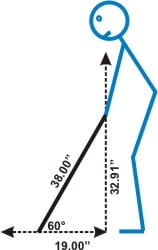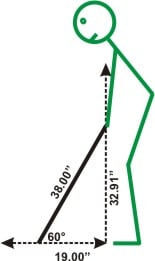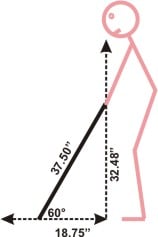Why are Golf Clubs Different Lengths? Part 2 of 2
For someone new to the game, they may not know that custom golf clubs come in all different golf lengths within the same set. When asked why to a fellow golfer, many may just shrug their shoulder or scratch their head and simply say, “Because that’s the way they are and have been so for a long, long time”. While tradition is an integral part of this game, there must have been a rhyme and reason why our golfing forefathers made each club a different length.
 Golf Club Length Affects the Distance You Hit the Ball
Golf Club Length Affects the Distance You Hit the Ball
There are two different reasons for varying the length of the clubs. The first of which is the distance one hit each club. Two of the key components to distance are primarily the loft of the club, while a secondary is its length. One might reason if all the clubs were the same length, then it might be easier to replicate each shot. While that might be true, the potential length that one may hit each club would be compressed throughout the set. As a club is longer (as well as lighter), then it can be swung faster up to a limit. The increased length provides greater leverage and speed to hit the ball further if solid contact is to be made. Shorter clubs are designed not for length, but rather precision. One analogy could be made that someone that does a lot of repair around the house might have a drawer full of different length screwdrivers. Each length is used for a specific application. A short, stubby screwdriver is used when one wants to get close to their work, while a longer screwdriver might be used for more leverage it to get to a hard to reach place.
In a typical set of golf club irons (#3-9, PW and SW) the length can vary by 3.5” (see how length is measured). But this only tells part of the story. In order to hit the ball with the center of the sole touching the ground just before impact then the distance of the ball outward from your wrists will be 4.5” further away on a #3-iron than a sand wedge (SW). In addition, the height of wrist from the ground will be approximately 1.55” higher on the #3-iron than the SW. The change in length from one club to the next is small and may not be noticeable, but throughout the set it is.
Golf Club Length Factors in Based on Your Height
The secondary reason for different lengths is to accommodate the size (or dimensions) of the golfer. While this may sound simplistic it is often not practiced by manufacturers. To understand this statement, let us look at purchasing golf shoes. Let’s say we want a Men’s Nike shoe. In one particular model it might be made in 30 different sizes if you include shoe width (medium and wide) into the fold. For a pair of ladies shoes, there may be another 17 different sizes to choose from. However, if you were to buy a set of golf clubs off of the rack, you are basically going to have two different lengths to choose from; Men’s or Ladies standard.
It becomes obvious that manufacturers know that not all people are the same size. Some of those same companies go to get lengths in producing and providing the proper instruction for fitting the correct sized shoe or even golf glove, yet only offer two options for their stock length (although many manufacturer’s can allow for customized lengths). The key difference is your foot size or hand size is fixed and your height is not. That is to say that a glove or shoe should be a tight fit and be comfortable, while a golfer’s height can be adjusted based upon how much tilt (spine angle) occurs at the waist, how far the person’s feet are apart, how much flex or bend in the knees occurs or how far away the player’s arms are away from the body (arm angle). The human body is truly amazing as it can adapt.
Club Length: Men versus Women
The reason for a two different length model by manufacturers is somewhat based on statistics, like the average height of an average male and female. The average woman’s height in the U.S. is approximately 5’ 5” (165.1cm), with about 68% between 5’ 2” and 5’ 7”. The average male is approximately 5’ 10” (177.8cm) with nearly 68% between 5’6” and 5’ 11”. Because of this limited range manufacturers can build to one specified length and fit conceivably 2/3 of the population of each gender and limit inventories. The third of the remaining golfers can be custom fit to different lengths than standard.
 The difference in the club length is typically 1” shorter for women’s than men’s because of the height differential. Length may also vary in the same model from steel to graphite, with graphite-shafted irons being potentially ½” longer to create a specific swingweight. In the following example, we want to show different models in proportion. The first of which is a 5’10” (177.8cm) male (blue model) with a 38” steel-shafted #5-iron.
The difference in the club length is typically 1” shorter for women’s than men’s because of the height differential. Length may also vary in the same model from steel to graphite, with graphite-shafted irons being potentially ½” longer to create a specific swingweight. In the following example, we want to show different models in proportion. The first of which is a 5’10” (177.8cm) male (blue model) with a 38” steel-shafted #5-iron.
If the club was returned to impact with the center of the sole touching the ground and the hosel / shaft at a 60° angle from the ground line it would form a triangle, where the heel of the club would be 19.00” outward of butt end of the shaft. In addition, the butt end would be 32.91” above the ground line, which would coincide with the wrists of the golfer if the club was held at the end of the grip. It is important to remember that this may not be the position of the club or golfer at address. There are a number of dynamic factors that have an influence from the starting address position to the final
angles at impact.
Club Length for Taller Golfers
Now, let us use a proportionate model, but that is a 6’ 4” (193cm) male. In order to use the same length club and bring the club into the same sole centered position, then it would look like the following diagram in green. The importance of having the center of the sole of the club is to provide the proper lie angle. We will leave this discussion for another article when the contact is made on the heel or toe of the club’s sole.
 In order for the taller person to have the wrists at the same height off of the ground and the heel of the club outward from the butt of the golf shaft, then the player’s angles need to change. It could be just one, like arm angle, or in tandem such as the arm angle, spine angle and knee flex. Remember, the club did not change length; the golfer adapted to the length of the club. In this case the green model has tilted more at the waist and the arm angle is closer to the body effectively shortening the player’s height.
In order for the taller person to have the wrists at the same height off of the ground and the heel of the club outward from the butt of the golf shaft, then the player’s angles need to change. It could be just one, like arm angle, or in tandem such as the arm angle, spine angle and knee flex. Remember, the club did not change length; the golfer adapted to the length of the club. In this case the green model has tilted more at the waist and the arm angle is closer to the body effectively shortening the player’s height.
 Many lady golfers will use graphite-shafted irons more so than men will to help decrease weight for feel and to increase their swing speed for greater distance. As mentioned before, ladies golf clubs are typically 1” shorter than men’s, but graphite shaft clubs tend to be ½” longer to obtain a normal swingweight or heft to the club. The next diagram will illustrate a proportionate model (in pink) that stands 5’ 5” (165.1cm) and uses a 37.5” #5-iron. Again, the center of the sole contacts the ground to form the triangle where the heel of the club would be 18.75” outward of butt end of the shaft and the butt end would be 32.48” above the ground line.
Many lady golfers will use graphite-shafted irons more so than men will to help decrease weight for feel and to increase their swing speed for greater distance. As mentioned before, ladies golf clubs are typically 1” shorter than men’s, but graphite shaft clubs tend to be ½” longer to obtain a normal swingweight or heft to the club. The next diagram will illustrate a proportionate model (in pink) that stands 5’ 5” (165.1cm) and uses a 37.5” #5-iron. Again, the center of the sole contacts the ground to form the triangle where the heel of the club would be 18.75” outward of butt end of the shaft and the butt end would be 32.48” above the ground line.
In order to be in this final position at impact, the model must have a more stance and the arms are reaching outward and more upward relative to the other two models. Even though the pink and green models represent an 11” difference in physical height, it shows how they can use a club that is only ½” different in its length.
In some cases, the standard length of a ladies or men’s club may not be in a position that feels comfortable and put’s that person in an athletic posture to be able to return the clubhead with a positive impact location (both on the center of the face and center of the sole). For instance, the person could be very tall or short compared to the average person, disproportionate arm length, overweight or possibly a well-endowed woman. In those cases, we need different length golf clubs. What length is best for you? Unfortunately, there is no magic formula and may require some experimentation on the player’s part or go through a thorough fitting.
Related Links:
How is the Length of a Golf Club Measured?

